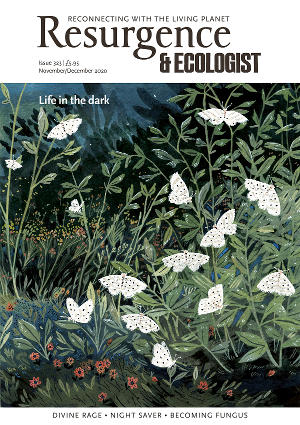I’m a relative newcomer to the world of Nature-noticing and Nature-worshipping. As a child, I didn’t pay much attention to the cherry blossoms arriving in spring or the arc of the sun’s trajectory on a midsummer’s day. Yet in my early thirties I became an organic food grower, and learning how to nurture plants from seed to harvest – and the right relationship with the ecosystems that make that possible – changed everything for me. Growing food has been the gateway through which I have uncovered how connected I am – we all are – to the natural world and its cycles and seasons and patterns.
I am a compulsive note-taker. I fill notebooks with scraps of half-recalled dreams and nuggets of Buddhist wisdom, alongside optimistic lists of books I want to read – eventually. I organise my life by scribbles and spreadsheets, my food-growing with calendars and weather forecasts. I’m drawn to any principle that I can organise my intentions and plans around, and if it deepens my awareness of Nature’s rhythms, all the better.
The moon holds a sacred place in spiritual traditions and Indigenous belief systems. Its force exerts influence over the movements of the natural world as it circumnavigates the Earth. Following the footsteps of ancient agriculturalists, some farmers and gardeners coordinate their growing efforts with the cycle of the moon. And since I’ve blamed many a turbulent night’s sleep and foul mood on the lunar pull over my emotional ocean, I readily took up the invitation to organise my seed-sowing and salad-harvesting around the moon’s monthly dance.
To garden by the moon is to pay attention to where we are in the lunar cycle and to act (or not) accordingly. The notion, at its most straightforward, proposes that just as the moon exerts a gravitational force that moves the tides of oceans and seas, so too does it influence the water-laden bodies of plants and the moisture in the soil. When the moon is waxing – growing towards fullness – water is being pulled up towards the sky, and when it is waning – retreating into newness – water is being drawn down into the earth.
There are more engaged approaches that consider the moon’s distance from the Earth or which astrological sign it’s passing through, but I haven’t yet explored the depths of those practices. Transcribed from one of my soil-encrusted growing journals, the descriptions below outline the directions that I do follow.
The New Moon Phase: this is the time to sow or transplant leafy annuals. Seeds easily absorb water and germinate quickly then, but leaves harvested during this time will not keep for long.
The First Quarter: this moon phase sees an increase in light, so plants and seedlings easily take up moisture from the soil at this time, and their ability to grow flowers and fruit increases. This quarter is best for sowing, planting and transplanting seedlings of fruiting plants, as well as trimming, pruning and mowing to encourage growth.
The Full Moon Phase: this quarter is the time to sow or plant root crops and perennials. It is also a good time for taking cuttings and dividing plants, as water is being pulled down into the earth for strong root growth. Medicinal herbs and plants are most potent when harvested in this phase.
The Last Quarter: this is the time to avoid sowing and planting and instead to work on weeding, mulching, making compost and improving the soil. Produce harvested at this time stores well, and pruning and mowing now decrease growth.
Opinions are understandably divided as to whether following lunar cycles has a notable effect on plant growth and the harvests they produce, but I’ve read enough affirmative anecdotes to at least attempt to grow like our ancient ancestors did. It wasn’t really possible when I was growing food in London, working one day a week on different sites, doing all the week’s jobs in one day.
Yet now, in the countryside, with a garden of my own, I’m with my plants every day and I’ve embraced the lunar guidance wholeheartedly this season. Against the blackness of the rural night skies, the moon throws light so bright across the garden that it casts deep-blue shadows, and the weight of its force is palpable. But I’ll have to wait until this time next year, when I can compare that season’s harvest to this year’s, before I can tell my own tales of tidal successes and failures.






